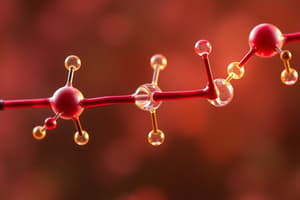Podcast
Questions and Answers
Which of the following is NOT a key feature of electron carriers in biological systems?
Which of the following is NOT a key feature of electron carriers in biological systems?
- Ability to directly convert light energy into chemical energy (correct)
- High solubility within their environment
- High affinity and specificity to transfer electrons in a chain
- Ability to undergo reversible redox reactions
What is the primary function of electron carriers in aerobic respiration?
What is the primary function of electron carriers in aerobic respiration?
- To break down glucose into pyruvate
- To facilitate the transfer of electrons from NADH and FADH2 to oxygen (correct)
- To transport oxygen to the mitochondria
- To directly synthesize ATP from glucose
Which molecule serves as the final electron acceptor in aerobic respiration?
Which molecule serves as the final electron acceptor in aerobic respiration?
- Oxygen (correct)
- Glucose
- Water
- Carbon dioxide
How does anaerobic respiration differ from aerobic respiration in terms of electron acceptors?
How does anaerobic respiration differ from aerobic respiration in terms of electron acceptors?
Why are electron transport chains considered crucial for cellular activities?
Why are electron transport chains considered crucial for cellular activities?
What is the primary function of electron transfer carriers in biological systems?
What is the primary function of electron transfer carriers in biological systems?
Which of the following classes of electron carriers is involved in the transport of both electrons and protons?
Which of the following classes of electron carriers is involved in the transport of both electrons and protons?
How does the redox potential of an electron carrier influence its role in electron transport?
How does the redox potential of an electron carrier influence its role in electron transport?
In what way is the movement of electrons coupled to proton pumping across a membrane?
In what way is the movement of electrons coupled to proton pumping across a membrane?
What is the primary energy currency of the cell, and how is it generated in relation to electron transport?
What is the primary energy currency of the cell, and how is it generated in relation to electron transport?
What factor can influence the efficiency of electron transfer in a biological system?
What factor can influence the efficiency of electron transfer in a biological system?
How does the electron transport chain contribute to cellular respiration?
How does the electron transport chain contribute to cellular respiration?
What aspect of cytochromes helps in tracking the flow of electrons through the electron transport chain?
What aspect of cytochromes helps in tracking the flow of electrons through the electron transport chain?
Flashcards
Electron Carriers
Electron Carriers
Molecules that transport electrons in a sequence during respiration.
Final Electron Acceptor
Final Electron Acceptor
A molecule that accepts electrons, oxygen in aerobic respiration forming water.
Anaerobic Respiration
Anaerobic Respiration
Cellular process using electron acceptors other than oxygen, producing less energy.
Electron Transport Chain
Electron Transport Chain
Signup and view all the flashcards
Photosynthesis and Electron Transport
Photosynthesis and Electron Transport
Signup and view all the flashcards
Electron Transfer Carriers
Electron Transfer Carriers
Signup and view all the flashcards
Flavoproteins
Flavoproteins
Signup and view all the flashcards
Iron-sulfur Proteins
Iron-sulfur Proteins
Signup and view all the flashcards
Cytochromes
Cytochromes
Signup and view all the flashcards
Quinones
Quinones
Signup and view all the flashcards
Redox Potential
Redox Potential
Signup and view all the flashcards
Proton Motive Force
Proton Motive Force
Signup and view all the flashcards
Study Notes
Electron Transfer Carriers: The Process
- Electron transfer carriers are molecules that facilitate the movement of electrons between different components in a biological system, often during redox reactions.
- These carriers are crucial for various cellular processes, including respiration, photosynthesis, and metabolism.
- The transfer often involves a change in the oxidation state of the carrier.
- Several key classes of electron carriers exist, including:
- Flavoproteins: Containing flavin mononucleotide (FMN) or flavin adenine dinucleotide (FAD), they act as electron shuttles.
- Iron-sulfur proteins: These proteins, containing iron and sulfur clusters, readily accept and donate electrons.
- Cytochromes: Protein complexes with heme prosthetic groups containing iron, vital for electron transport. Different cytochromes display distinct absorption maxima, aiding electron flow tracking.
- Quinones: Non-protein-based electron carriers, lipid-soluble, carrying multiple electrons and protons (e.g., ubiquinone).
- The carriers operate in a specific order according to their redox potentials.
- Redox potential quantifies a molecule's tendency to gain or lose electrons.
- Carriers with lower redox potentials are more likely to donate electrons; those with higher redox potentials are better electron acceptors.
- The sequential transfer of electrons from one carrier to the next is crucial for capturing energy released during the process.
- The movement of electrons is typically accompanied by protons, further affecting the carriers' reduction or oxidation.
- This flow is often coupled to proton pumping across a membrane, generating a proton gradient (key in ATP synthesis).
- In some electron transport chains, the energy released from electron transfer is used to pump protons across a membrane against their electrochemical gradient to establish a proton motive force.
- The proton motive force then drives the synthesis of adenosine triphosphate (ATP), the primary cellular energy currency.
- The efficiency of electron transfer is influenced by factors including carrier concentration, inhibitors, and temperature.
- The specific pathways and components of the electron transport chain vary across biological systems, yet the fundamental principles remain consistent.
- The electron transport chain plays a critical role in cellular respiration.
- Electron carriers act sequentially, conducting electrons from NADH or FADH2 to oxygen.
- Oxygen is the final electron acceptor in aerobic respiration, forming water as a byproduct.
- In anaerobic respiration, alternative molecules (e.g., sulfate, nitrate) act as electron acceptors, producing less energy than aerobic respiration.
Key Features of Electron Carriers
- Carriers possess specific binding sites for electrons.
- They can undergo reversible redox reactions (accepting and donating electrons).
- They exhibit high solubility within their environment.
- They maintain stability during redox state changes.
- They demonstrate high affinity and specificity for electron transfer within a chain.
- Spatial membrane arrangement promotes efficient electron transfer.
Application and Significance
- Electron transport chains are essential in aerobic respiration, producing most of the ATP for cellular functions.
- Understanding these chains is central to comprehending cellular energy production and energy transformation between molecules.
- Processes like photosynthesis also leverage electron transport for converting light energy into chemical energy.
- Disruptions in electron transport can lead to various cellular disorders and diseases.
- Exploring electron transport chain components and mechanisms is crucial for developing new therapies and efficient biotechnologies.
Studying That Suits You
Use AI to generate personalized quizzes and flashcards to suit your learning preferences.




